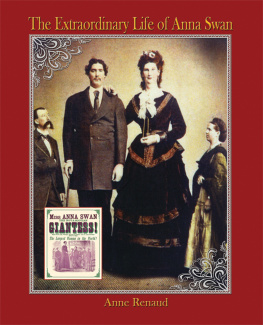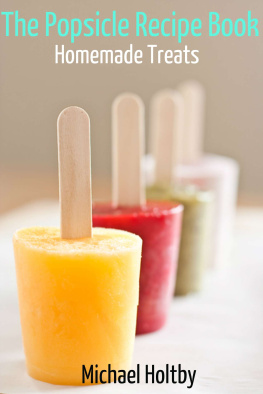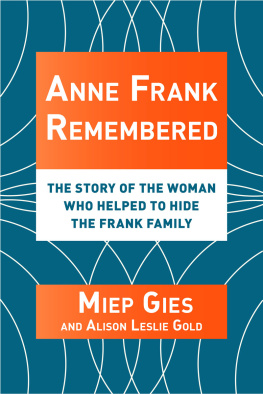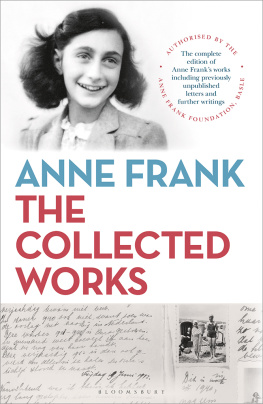Anne Renaud writes in both English and French. She is the author of over a dozen books for children, including Mr. Crums Potato Predicament and The True Tale of a Giantess: The Story of Anna Swan . She is also a regular contributor to childrens magazines. Anne lives in Westmount, Quebec where you will often find her eating a frozen treat!
Milan Pavlovi lives in Toronto, Ontario, with his family. When he is not illustrating picture books, drawing or playing the ukulele, he is teaching visual communication and illustration at OCAD University and Seneca College.
F rank William Epperson knew what he wanted to be when he grew up.
And everyone in Franks family knew, too. Because in case they forgot, he reminded them often.
When not busy with his schoolwork or chores, Frank could be found
adventuring with his brother Cray,
practicing his cornet,
or learning magic tricks.
He also pondered important questions.
Do ants have ears?
Do goldfish sleep?
Do woodpeckers get headaches from pecking all day?
But Franks favorite pastime was inventing. And to invent, Frank knew he had to experiment. So off he would go to his laboratory his back porch.
There, he doodled and designed.
Tinkered and tested.
Analyzed and scrutinized.
By the time Frank was ten years old, he had already masterminded his first invention: a handcar with two handles. At twice the speed of a regular one-handled handcar, Frank whizzed down the streets of his neighborhood.
Frank also experimented with liquids.
Why Wont They Play Together?
How to do your own experiment with liquids
Stuff you need:
mL ( c.) cooking oil
mL ( c.) water
a drinking glass
What happened?
The oil rose above the water because it is less dense (lighter for its size) than water. No matter how much you mix these two liquids, they will always separate. Why? Just like magnets are attracted to other magnets, water molecules are attracted to other water molecules. But oil molecules and water molecules are not attracted to each other.
One more thing:
Food coloring is made of water. See what happens when you add a few drops of food coloring to the glass. The drops will slowly travel through the oil and only mix with the water.
Molecules are like building blocks. Just as a house is made of bricks, you and I and almost everything on Earth are made up of minuscule particles called molecules. Molecules are so small they can only be seen with a very powerful microscope.
What to do:
Pour the cooking oil into a glass.
Add the water.
Mix the two liquids together.
Wait minutes.
But what Frank loved most was experimenting with flavored soda waters. The kind that hissed and wheezed when he held a glassful to his ear, and sent tangy bubbles galloping across his tongue with every gulp.
Frank had his heart set on inventing the yummiest, most thirst-quenching, lip-smacking soda water drink ever!
So off Frank would go to the corner store to buy the flavored soda water powders he needed for his experiments. Often with his little brother Cray tagging along.
Cray was a handy taster for Franks concoctions. Some of his attempts were unsuccessful you could even say they were disastrous!
But Frank just kept on trying.
A Whole Lot of Fizzing Going On
How to make your own lemon-flavored soda water
Stuff you need:
mL (4 tbsp.) lemon juice
mL (1 c.) water
a drinking glass
2.5 mL ( tsp.) baking soda
mL (1 tsp.) sugar
What to do:
Pour the lemon juice into the glass.
Add the water.
Add the baking soda and mix well. You should see some fizzing action going on.
Now taste your lemonade. You can add the sugar to sweeten.
One more thing:
Try this experiment with other citrus fruits like limes, oranges and grapefruit.
What happened?
The baking soda reacted with the lemon juice and created a gas called carbon dioxide. This is what makes the fizz.
One day, Frank and the other children in his neighborhood decided to build a miniature amusement park. There was a theater, a merry-go-round and a scenic railway.
Frank was assigned the soda water stand which suited him just fine. He could share his soda water creations with all his friends.
It was also around this time that something peculiar happened: the temperature dipped then plunged.
This would not have been unusual had Frank lived in Moose Jaw, Saskatchewan, or Pocatello, Idaho, where it could be bitterly cold in winter. But he lived in San Francisco, California, where only rarely did the temperature drop below freezing.
So Frank tried another experiment. He left a glass of flavored soda water outside overnight.
When he woke the next morning, Frank ran to his back porch to discover his soda water had frozen solid. He could no longer sip it. He had to lick it like a lollipop!
Frank had invented a frozen drink on a stick!
As he grew older, Franks invention did not melt from his memory. He just tucked it away in a corner of his mind. And there it stayed while he and his sweetheart, Mary Frances, began raising their gaggle of children.
But when Frank noticed more and more people eating chocolate-covered ice-cream bars, off he went to his laboratory now his garage to experiment.
Frank found a way to make many of his drinks on a stick at the same time.
With test tubes to mold them,
wooden sticks to hold them,
and a cool way to freeze them.
For Franks drinks on a stick to freeze, they had to be cold very cold. Colder than 0C (32F), the freezing point of water. Why? Because their ingredients, like sugar and flavoring, lowered their freezing point.
So what did Frank do? He built a freezing box that held dozens of test tubes suspended in a mixture of crushed ice and salt. Frank knew that salt lowered the freezing point of water, and that salty water froze at a much lower temperature than plain tap water. The salt-and-ice mixture would be colder than 0C (32F).
The Big Freeze
How to show that salt lowers the freezing point of water
Stuff you need:
drinking glasses
mL (4 tbsp.) salt
mL (2 c.) lukewarm water
What to do:
Pour mL (1 c.) of lukewarm water into each glass.
Add the salt to one of the glasses and mix well until the salt is fully dissolved.
Put both glasses of water into the freezer and wait hours.
What happened?
The plain tap water froze, but the salty water did not. Why? Water becomes ice when it reaches 0C (32F). But if there is sodium chloride, also known as salt, in the water, it lowers the waters freezing point. The temperature of the salty water needs to be colder than 0C (32F) for it to freeze.
One more thing:
Touch the glass of salty water. It feels colder than the glass of frozen water. Cool!
Franks drinks on a stick also had to freeze quickly. If they froze too slowly, the sugar and flavoring, which were heavier than water, settled at the bottom of the test tubes, leaving just flavorless frozen water at the top. Frank wanted his treats to have the same tasty flavor throughout.
The salt-and-crushed-ice mixture surrounding the test tubes was so cold it froze the liquid inside the tubes in minutes.
A Frozen Treat in a Flash!
How to make your own frozen treat in only five minutes
What to do:
Pour the juice into the small plastic bag. Try to remove the air from the bag and make sure it is well sealed.
Pour the ice cubes, water and salt into the large plastic bag.
Put the smaller bag of juice inside the larger bag. Make sure the larger bag is well sealed.
Put on your oven mitts and shake the bag back and forth for about minutes to mix the ice, water and salt around the smaller bag.
Next page










